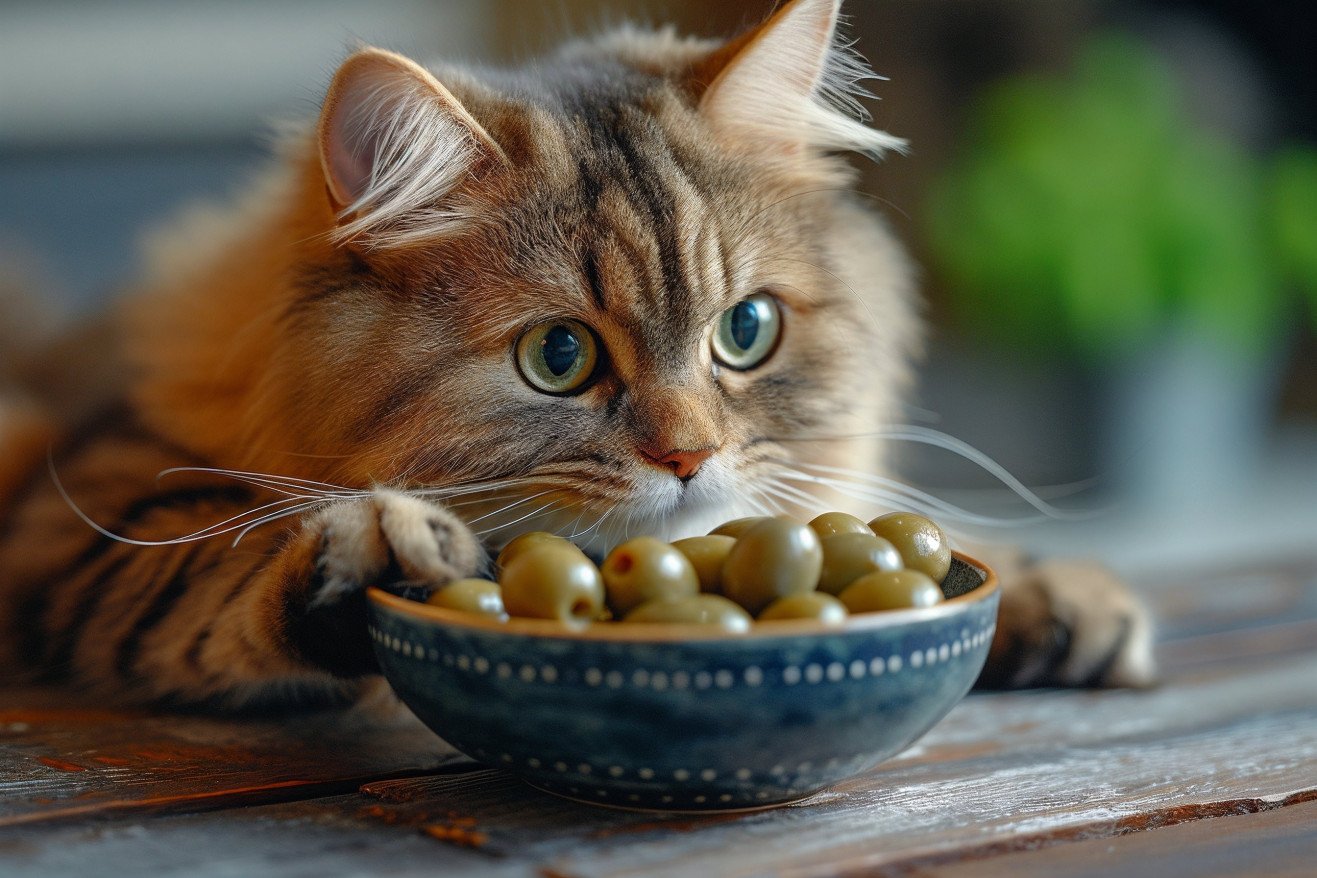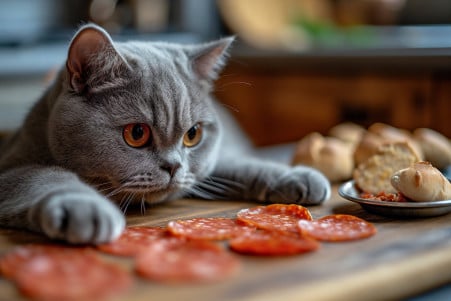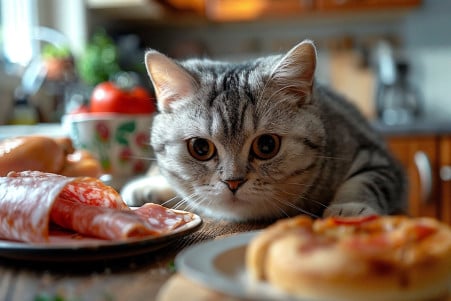Can Cats Eat Olives? A Guide to Feline-Friendly Treats
10 February 2024 • Updated 8 February 2024

Olives are a delicious snack for people, but what should you do if your cat wants to get in on the action? While cats can eat small amounts of unsalted, unseasoned olives as an occasional treat, it’s best to limit their intake and make sure the olives are pitted because of the high sodium content and potential choking hazard.
As always, talk to your vet before introducing new foods into your cat’s diet.
To understand the potential impacts of feeding olives to cats, we’ll look at research at the intersection of veterinary science, feline nutrition, and animal behavior. This will involve examining research on cats’ basic nutritional requirements and the health risks associated with some human foods.
Through this analysis, this article will offer a well-rounded view of how olives might impact your cat so you can feel confident about the choices you make regarding their treats.
Can cats eat olives?
Nutritional Needs of Cats
Cats are obligate carnivores, which means that they need certain nutrients that are found in animal flesh to survive. This is due to the fact that cats have evolved as hunters and have a digestive system that is designed to process a diet that is high in animal protein.
As the Washington State University Veterinary Teaching Hospital notes, this is evident in the way that cats’ teeth and liver have evolved to process animal products.
Protein is especially important in a cat’s diet. According to PetMD, protein is the most important nutrient for cats, providing essential amino acids and acting as the main source of energy. AAFCO guidelines recommend that a cat’s diet contain at least 26% protein for maintenance and 30% protein for growth.
Fats, especially omega-3 and omega-6 fatty acids, are also important for maintaining a cat’s skin and immune system health. On the other hand, carbohydrates are less important in a cat’s diet since they get very little energy from them, and too many carbs can contribute to obesity.
While olives don’t provide any essential nutrients for cats, it’s important to know the nutritional roles that olives might seem to fulfill in a cat’s diet. When thinking about why cats might be interested in olives, it’s important to consider whether their attraction to the food is based on nutritional needs or sensory preferences.
Solving the Riddle: Why Do Cats Like Olives?
While the fact that cats like olives may seem strange in light of their carnivorous diet, there are a few reasons why this may be the case. According to a study from Noots Pets, the compound in green olives that cats respond to is similar to nepetalactone, the active ingredient in catnip, and can cause a reaction in cats that can make them seem more playful or even a little goofy.
However, this reaction isn’t universal, and cats’ reactions to olives can vary, with some cats not responding to them at all.
The sensory experience of olives, including their taste and smell, may be what draws the cats that do respond to them in. While olives aren’t part of a cat’s natural diet, their smell and taste may appeal to a cat’s sense of curiosity.
As The Dodo explains, the reason cats may like green olives is that they contain isoprenoids, which, like catnip, bind to receptors that can change a cat’s behavior.
That said, it’s important to note that cats’ attraction to olives is primarily sensory and behavioral, rather than nutritional. Since olives don’t have the protein-based benefits that cats need, their love of olives isn’t based on a nutritional requirement. Instead, cat owners should be aware that while olives may provide a fun distraction for their pets, they don’t have a meaningful impact on their nutritional health.
Assessing the Effects of Olives on Cats
If you’re thinking about giving your cat olives, it’s important to consider the potential benefits and risks. While a study from Spot Pet Insurance notes that olives can help fight free radicals and reduce arthritis by providing antioxidants and anti-inflammatory properties, the nutritional value of olives, which are low in protein and high in fat, is not ideal for cats.
The high sodium content in olives is a more pressing issue because it can be harmful to cats. As the Oakhurst Veterinary Hospital explains, cats require much less sodium than humans, and exceeding their daily intake can lead to hypernatremia, which requires immediate veterinary care and can cause symptoms like vomiting, diarrhea, and seizures.
In addition to the health concerns, the physical properties of olives can also be dangerous. It’s important to remove the pits from olives before giving them to cats because they can be a choking hazard. As a result, if you do decide to give your cat olives, it’s best to do so with caution and only on rare occasions to avoid any potential health problems.
While giving your cat a small piece of an olive may seem harmless, because of the high sodium content and choking hazard, it’s best to stick to giving olives to humans. The next section will take a closer look at the important topic of cats and sodium and how it impacts their overall health.
What Does Sodium Do for Your Cat?
Sodium is an essential electrolyte that helps regulate blood pressure and muscle function. That said, cats have relatively low sodium requirements and high levels can be dangerous.
As noted in ScienceDirect, the minimum requirement for adult cats is 0.4 mmol of sodium per kg of body weight per day. This is equivalent to about 0.8 g of sodium per kg of diet for maintenance, which is enough to support normal physiological processes without leading to deficiency symptoms like weight loss or anorexia.
That said, the difference between what’s necessary and what’s too much is slim. The American College of Veterinary Internal Medicine 2015, cited on PetMD, notes that sodium levels up to 740 mg/MJ metabolizable energy can be considered safe for cats, with no adverse health effects observed at this level. This is the current safe upper limit (SUL) for sodium in cats.
You can control your cat’s sodium intake by choosing the right diet and being careful with treats. Make sure to check pet food labels for sodium and ask your vet for personalized advice. High-sodium foods, like olives, should be fed in moderation to avoid potential health problems like high blood pressure and kidney disease. By staying mindful of your cat’s sodium intake, you can help them stay healthy and happy.
Healthy and Tasty Treats for Your Cat
If you want to spoil your cat with treats, it’s important to make sure that the treats you choose are in line with their obligate carnivore diet. High-protein treats like freeze-dried meat or fish can give your cat a healthy, nutrient-dense treat that’s in line with their natural dietary needs.
The Cornell University College of Veterinary Medicine recommends that treats should make up no more than 10–15% of a cat’s daily caloric intake to ensure that they are nutritionally balanced.
Catnip and other cat-friendly herbs can provide a safe and fun alternative to olives, and they often produce a high without the need for consumption. These herbs can be given in their dried form or in toys that have been infused with catnip.
You can also give commercially available treats that have been specifically formulated for cats. These treats are regulated by the Association of American Feed Control Officials (AAFCO). The VCA Animal Hospitals recommends that you choose high-quality commercial treats that are nutritionally balanced.
It’s also important to remember that cats like variety, so providing a mix of treats can make mealtime more interesting. However, it’s important to make sure that you don’t overdo it, as too many treats can lead to weight gain and nutritional deficiencies. By choosing treats that are both healthy and tasty, you can make sure that your cat gets the best of both worlds.
Navigating the Olive Aisle: What to Know About Your Cat’s Snack Options
As we wrap up our investigation, it’s clear that while cats are interested in olives, they should be given to cats with caution and in moderation. The fact that cats may be attracted to olives due to the presence of compounds that are also found in catnip doesn’t change the fact that cats are obligate carnivores and need to eat a diet that reflects that.
It’s also important to note that the high sodium content and choking hazard of olives should be taken into account, and that pet parents should consult their vets before adding olives to their cats’ diets.
This is just another reminder that when it comes to cat treats, moderation is key, and pet parents need to be mindful of their cats’ diets and make sure that they’re feeding them in a way that supports their unique nutritional needs. This requires staying informed and working with a vet to make sure that any new treats that are added to a cat’s diet are supporting their health and well-being.
In the end, being a responsible pet parent means that you’re always learning and keeping up with the latest information about veterinary nutrition. It’s a path that’s characterized by curiosity, concern, and a commitment to your feline friend’s well-being. By providing them with love and appropriate treats, you can help ensure that they live their best lives and bring you the joy and companionship that you’ve come to expect.


